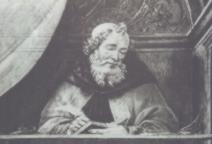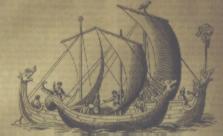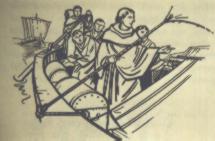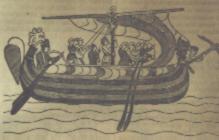Pyramids In The Pacific

The Unwritten History Of Australia
Chapter 19
|
"A Land Most Noble" Mediaeval European Knowledge of the Great South Land |
"God will prevail, it is said, against them and he will wipe
out all the gods of the peoples of the earth, and they
will adore him, each one from its own place, all
the peoples of the islands.
And indeed not only the peoples of the islands, but the
universal orb of the earth, saying; the universal
ends of the earth will remember God and be converted
to him and the people of the earth will adore his fatherly
aspect since God is king and rules over the people".
Saint Augustin
{354-430 AD}
Book Of Prophesies.
|
Chapter
19 Images
|

|
Saint Augustin
The above statement of Saint Augustin reveals two interesting points {1} that he recognised the earth to be a sphere, and {2} that he recognises the existence of lands at the furthest ie "universal ends" of the earth. Saint Augustin also predicted that other lands existing beyond Europe would one day be found.
In this, and the following three chapters, I intend to show that what have been called the Dark Ages were not entirely 'dark' and that the Church openly pursued a policy of general ignorance in matters of science, secretly the Church fathers encouraged certain scholars to investigate theories about the universe and the earth that were not accepted in Church dogma, as long as these scholars did not become too 'vocal' about their findings!
It is a modern-day fallacy that all Mediaeval Europeans believed in a flat earth. True, the average peasant believed this; but scholars both within and outside the Church accepted otherwise. What the Church was in general disagreement over was the size and continental make-up of the earth.
Church scholars knew that the northern hemisphere was inhabited, whereas the southern hemisphere was shrouded in mystery. Many clergy believed that it was the location of the terrestrial paradise, where mankind first arose {a belief handed down from the distant past, as we have seen}, ie the "garden of Eden".
Others preferred the view that it was the location of Purgatory; a hot desert land and a land of "heat and flies", with Hell, a land of freezing cold, beneath.
Indeed, these "Infernal Regions" as they were generally described, had confusing descriptions, but their origins extended back to ancient Greek, Egyptian and Sumerian times. It was also described as a great southern continent, guarded by giant beings and other weird monsters.
It was also a land of indescribable wealth, and this was enough to attract the attention of many adventurous explorers. Theories as to what one might find in this land were many and varied. Gautier de Metz, for example, in his poem on the "L'Image du Monde", written in the 13th century, places the terrestrial Paradise in an unapproachable region of Asia, surrounded by flames and having an armed angel to guard the only gate.
In the Book of Chronicles of the Abbey of St. Albans, England is the record of Matthew Paris, written in the year 1228, concerning a visit to this Abbey by a certain Archbishop of Armenia, for the purpose of seeing relics of the saints at various places in the kingdom. He carried a letter of recommendation from the Pope. While at the Abbey he spoke with the Abbot and monks on many strange things concerning the oriental lands that he had visited.
His interpreter, a knight in his party, related that the Arabs had long been trading with these lands which lay beyond India at the very southmost end of the earth. Here lay Paradise, but also a land of cold and darkness, Purgatory. Of all the myths that originated in the Middle Ages, those concerning the location of Paradise and Purgatory are the most numerous and fascinating.
At times both would be confused and associated with the great southern continent. Some Chroniclers even speculated that in this land lay the fabled fountain of Youth. A 12th century manuscript preserved in the British Museum tells us that Paradise is situated on the eastern part of the world. A pleasant beautiful land where, we are told dwelt the Phoenix; a large bird which may or may not be the emu.
He is described as the lord of all birds. Countless angels guard this land located amid the waters of the Indian Ocean. The Irish monk, Saint Brendan, is said in no myth to have sailed there to see the land for himself. Another myth concerning this land was that it was the home of the "Blue Flower of Paradise". Miraculous powers were said to be gained from its juices.
This flower was also known to the Brahmins of India, who said it was only to be found in Paradise. "it blooms nowhere else" their literature states in more than one account. Both Indian and Tibetan texts of antiquity describe its medicinal properties. Yet to date this legendary flower has not been identified, despite efforts to link it with more than one native Australian species.
Wherever the miraculous flower grew gold was said to be found in great profusion.
|
Pyramids
in the Pacific Images
Ch 19
|

|

|

|
|
Saxon Ships |
Saint Brendon Monk |
King Harold |